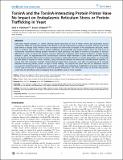TorsinA and the TorsinA-Interacting Protein Printor Have No Impact on Endoplasmic Reticulum Stress or Protein Trafficking in Yeast
Author(s)
Valastyan, Julie Suzanne; Lindquist, Susan
DownloadValastyan-2011-TorsinA and the Tors.pdf (3.094Mb)
PUBLISHER_CC
Publisher with Creative Commons License
Creative Commons Attribution
Terms of use
Metadata
Show full item recordAbstract
Early-onset torsion dystonia is a severe, life-long disease that leads to loss of motor control and involuntary muscle contractions. While the molecular etiology of the disease is not fully understood, a mutation in an AAA+ ATPase, torsinA, has been linked to disease onset. Previous work on torsinA has shown that it localizes to the endoplasmic reticulum, where there is evidence that it plays roles in protein trafficking, and potentially also protein folding. Given the high level of evolutionary conservation among proteins involved in these processes, the ability of human such proteins to function effectively in yeast, as well as the previous successes achieved in examining other proteins involved in complex human diseases in yeast, we hypothesized that Saccharomyces cerevisiae might represent a useful model system for studying torsinA function and the effects of its mutants. Since torsinA is proposed to function in protein homeostasis, we tested cells for their ability to respond to various stressors, using a fluorescent reporter to measure the unfolded protein response, as well as their rate of protein secretion. TorsinA did not impact these processes, even after co-expression of its recently identified interacting partner, printor. In light of these findings, we propose that yeast may lack an additional cofactor necessary for torsinA function or proteins required for essential post-translational modifications of torsinA. Alternatively, torsinA may not function in endoplasmic reticulum protein homeostasis. The strains and assays we describe may provide useful tools for identifying and investigating these possibilities and are freely available.
Date issued
2011-07Department
Massachusetts Institute of Technology. Department of Biology; Whitehead Institute for Biomedical ResearchJournal
PLoS ONE
Publisher
Public Library of Science
Citation
Valastyan, Julie S., and Susan Lindquist. “TorsinA and the TorsinA-Interacting Protein Printor Have No Impact on Endoplasmic Reticulum Stress or Protein Trafficking in Yeast.” Ed. Philipp J. Kahle. PLoS ONE 6 (2011): e22744.
Version: Final published version